PVTA: P11 (Holyoke Community College/Springfield Express)
What, you thought I was done with the PVTA? Nope, I still have to do the school year routes! Sam and I took Peter Pan out there recently so that I could truly complete the system. Let’s start things off with the P11, an express route from Springfield to the Holyoke Community College!
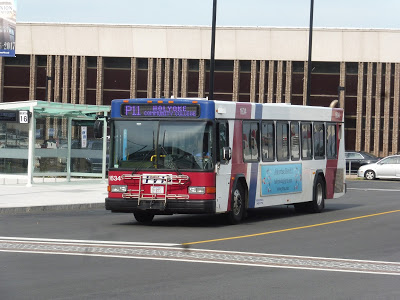 |
| Our last bus from Springfield! |
We boarded the bus at Union Station, but before it can get onto the highway, it has to do a little loop through Springfield. Thus, we went down Dwight Street first, running by the backlots of downtown Springfield. We soon turned onto Harrison Ave, making a pretty busy stop along there, then we turned onto Main Street, running down the city’s main drag.
 |
| Our last time seeing this “beautiful” “skyline.” |
We went under the Union Station tracks, coming close to the station again, but we kept on going. After a post office and some office buildings, we merged onto Plainfield Street, then immediately took an on-ramp to I-91. Express time!
 |
| A street seen from the highway. |
We had somewhat urban views for a bit, including of the PVTA garage, but soon it got woodsey. I-391 split off from the highway just before we crossed the Connecticut River, offering an amazing view as always. The woods continued on the other side.
 |
| Lovely! |
We went over I-90 and its corresponding interchange, then the sight of the huge Holyoke Mall let us know that we were almost there. Thus, we took Exit 15, then turned onto Lower Westfield Road and Homestead Ave. It was fairly industrial near the highway, but it soon turned residential.
 |
| Coming out of the interchange. |
We passed a school, then a few businesses when we turned onto Westfield Road. Next, we turned onto Doyle Drive, taking us on its windy woodsey path towards the Community College. We went by the Kids Place, then made our way onto Campus Road. Finally we arrived at the main campus of Holyoke Community College, and in typical PVTA fashion, the route was very very early. Hooray!
 |
| Hey, that’s red! |
PVTA Route: P11 (Holyoke Community College/Springfield Express)
Ridership: The ridership on the P11 is great. It gets about 600 riders per day, which doesn’t sound like a lot, but since the route doesn’t have too many trips, it averages out to about 30 people per trip. That’s right on par with mine, which did indeed have about 30 people, all going from Springfield to the community college.
Pros: This is a really fast way of getting from Springfield to Holyoke Community College – the trip is scheduled to take about 20 minutes, and since this is the PVTA, the bus is likely to be early! The schedule for the P11 is good too, with a bus every hour on school days only, from 8 to 5. There are additional trips at 5:30 and 9:30 PM on Mondays through Thursdays, which I don’t entirely understand, but I’m sure they serve some purpose.
Cons: The timetable is set up really weirdly: why is Harrison Ave in Springfield the main timepoint, rather than Union Station? It’s not a huge deal, but it makes the schedule hard to read, at least to me. Maybe the ridership is bigger from Harrison Ave than Union Station.
Nearby and Noteworthy: It’s basically meant to serve Holyoke Community College exclusively, so I guess that’s that!
Final Verdict: 8/10
The P11 serves its purpose very well, transporting students to the community college in the fastest possible way. It gets a lot of riders per trip, and I’m pretty sure that college students get a free ride? I might be wrong about that, since I can’t find any information on it anywhere. I guess it doesn’t really matter either way, since this route is still great!
Latest MBTA News: Service Updates
Update
Full disclosure: I have not started writing the Downtown Crossing review. The reason for this is that I’m in the pit band for my school’s production of West Side Story, and next week is Tech Week. That means I’m going to be getting home at 10:30 every night with absolutely no time to write. That’s why I basically spent my weekend writing five days worth of blog posts, which Sam will be publishing every day.
So, to summarize: posts every day next week, but Downtown Crossing won’t be for a while. Thanks for being patient, I know many of you are looking forward to it.
PVTA: 36 (Olympia Drive/Atkins Farm)
A little over 3 months after I left Amherst, we’re finally finishing my summer tenure with the PVTA! And what better way to end that summer with a summer-only UMass route? Yes, today we’ll be looking at none other than the 36, a route which kinda defies logical explanation…
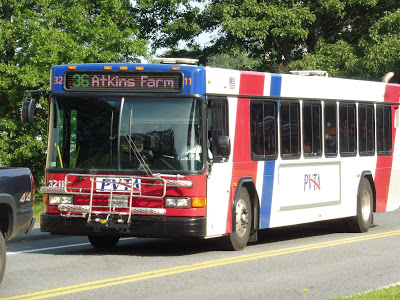 |
| A bus on the route, but I can’t remember for the life of me where this was. |
This route starts in the weirdest place: the Atkins Farms grocery store. It doesn’t go into Hampshire College, which is right next to the grocery store – it just kinda starts at the grocery store. I guess it makes sense in a way, but it’s just such an odd place to start. It also deviates right into the parking lot, unlike the other routes around here, which just go past it on their way to Hampshire College.
 |
| Hanging out in the Atkins Farms parking lot. |
We looped our way out of the parking lot and made our way through what is apparently the only double roundabout in Massachusetts! Wow, if that isn’t the coolest thing ever, I don’t know what is (note: slight sarcasm, but just a tinge of nerdy seriousness!). We headed up West Street, which was basically just woods and farmland for a while.
 |
| The long and winding road. |
Eventually, houses started to line the street, and there was even some suburban retail with parking lots at the intersection with Pomeroy Lane. It went back to being residential after that, and it was like that for quite a while. We did pass quite a beautiful view of some rolling hills at one point, though.
 |
| I love this view! |
The road was called South Pleasant Street now. We eventually went by Amherst College, and soon after that we were in Amherst Center. There were businesses everywhere for a little while, but as we got further away from the center, they gained parking lots in front of them.
 |
| Foliage in front of Amherst College. |
Unlike other UMass routes, which go directly to, you know, UMass, the 36 has a different agenda in mind. Thus, instead of continuing down North Pleasant Street, we merged onto East Pleasant Street, which does in fact go east of the campus. It was mostly houses for a while, aside from a few fringe UMass buildings at a certain point.
 |
| There was some foliage, too! |
Soon after those fringe buildings, we had to make a deviation onto Olympia Drive. We looped around a little complex up there consisting of the UMass admissions building, a housing development called Olympia Oaks, and a fraternity. After all that, we returned to East Pleasant Street for a bit before turning onto Eastman Lane outside of the UMass police and fire stations.
 |
| The police station. |
We headed down a woodsy hill, then we passed some student housing. It got more and more abundant as we came into the campus proper, where we turned onto North Pleasant Street at a roundabout. We headed through the campus, but Sam and I got off at the southernmost stop, the Studio Arts Building, while the bus continued on to go back to Atkins Farm.
 |
| The bus at UMass. |
PVTA Route: 36 (Olympia Drive/Atkins Farm)
Ridership: Darn it, another route without online ridership statistics? Alright, I guess I’m on my own, then. The 36 never seems to get that many people, but it gets enough – my trip had maybe 10-15 people who rode.
Pros: I guess it connects the residential areas around UMass to Atkins Farms? I mean, I honestly don’t know what this thing does, but it gets passengers, so who cares? It runs every 45 minutes, but only during school holidays – not a bad schedule, given the ridership.
Cons: I guess it’s mainly a question of “Why does this route exist?” It has to be said that the 36 doesn’t make a whole lot of sense. I mean, it’s sort of covering for the 34/35 and 38 routes, which don’t run over the summer, but only small sections of them? I dunno.
Nearby and Noteworthy: Atkins Farms is the main place this route serves, I guess. UPDATE: I’ve gotten a LOT of comments on this post and on Facebook about how amazing Atkins Farms is. I hear their cider donuts are incredible!
Final Verdict: 6/10
It’s good, I guess. I dunno, the 36 really just does its thing! It has its little loop around UMass and its little deviation to Olympia Drive and its little trip down to Atkins, and I guess that’s enough to give it a few riders. Sure, why not?
Latest MBTA News: Service Updates
PVTA: R14E (Springfield/Agawam Industrial Park)
Here’s another lost PVTA bus! The R14E was a rush hour-only (mostly) express route from Springfield to, as the name suggests, the Agawam Industrial Park. It’s gone now, but I rode it over the summer before it was cut, so we can see what it was like.
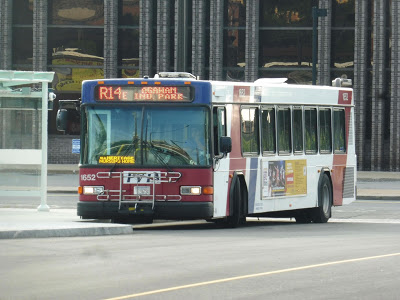 |
| The bus at Union Station. |
From Springfield Union Station, we headed down Dwight Street, which was generally urban, with buildings and parking lots. Next, we turned onto Harrison Ave, going through the heart of downtown Springfield and over the Memorial Bridge into West Springfield. We went around a rotary and merged onto Route 5, beginning the express portion that gave this route its “E” designation.
 |
| Crossing the Connecticut River. |
The highway was mostly woods, and we moved quickly down it. We went over the Westfield River, and soon after that, we reached another rotary and merged onto Route 57. This highway allowed for some views of the surrounding buildings, mostly houses, but we soon left it on the Main Street exit. After some suburban businesses with parking lots, we deviated into the Heritage Nursing Home facility – one of this route’s functions was transporting its workers.
 |
| A building within the complex. |
We now went south down Main Street, which was mostly houses with a good smattering of businesses as well. We also went by a school and a few churches. Next, we turned onto the residential Elm Street, which became Silver Street. There was a shopping plaza and some other suburban businesses at the intersection with Suffield Street, though.
 |
| “Guns and Gear, LLC.” |
It started to get a little industrial from there, with a few stretches of houses here and there. Once we made our way onto Bowles Road, though, it was all industrial. We just passed lots of random weird corporate buildings and offices before just kinda turning around and laying over at the end of the street. Sure!
 |
| What a weird place to end! |
PVTA Route: R14E (Springfield/Agawam Industrial Park)
Ridership: I wish I could find ridership numbers online for this one, but I can’t. I took the last trip at 6:30, and it only got about three riders – I really want to know if the other ones got more people.
Pros: This was a fast, convenient way of getting to the Agawam Industrial Park and the Heritage Nursing Home – the express portion was awesome.
Cons: The times for the route were really weird: 6:35, 1:30, 3:00, and 6:30. I mean, maybe those had something to do with the hours of the industrial buildings, but they seem to miss out the evening rush entirely!
Nearby and Noteworthy: Lots of industrial buildings, I guess, if that’s your cup of tea.
Final Verdict: 6/10
I dunno, I’m kinda ambiguous about this one. It was fine, I guess, but the schedule times and ridership numbers were questionable. Still, it was a lot better than what the route is like now – now they stick this thing along the regular R14, with trips at 6:15, 2:15, 3:15, and 4:15. What’s the point of running it with the local route, though? All it does is take ridership away from the normal R14 trips. It really isn’t helping anyone to run the route this way, and it takes much longer. Whereas the express trips could go out to Agawam and back in 55 minutes, the new local trips take 63, making it harder to interline or do another trip. Yeah, it’s kind of a mess now…
Latest MBTA News: Service Updates
PVTA: WS (Ware Shuttle)
Oh no oh no oh no OH NO OH NO OH NO! NOT ANOTHER ONE! NOT ANOTHER DEVIATORY MINIBUS SHUTTLE THING! All I can say about the Ware Shuttle is…beWare!!! Ha!
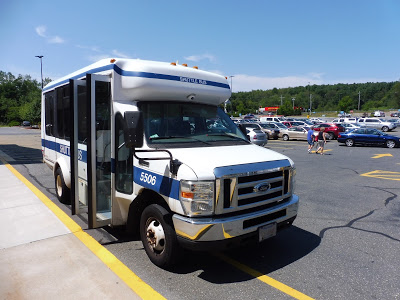 |
| OH MY GOD WHAT IS THAT?? |
This was quite possibly the worst minibus, and indeed the worst BUS, I’ve ever been on in my life. The vehicle that the shuttle normally uses was out of service, I guess, so they had to use this horrible piece of trash. The seats were falling apart, the heat was blasting, the smell was disgusting, and…did somebody say JIGGLY WHEELCHAIR LIFTS?
 |
| EWWWWWW!!!!!! |
We made our way out of the Ware Walmart and went onto Palmer Road, traversing the one section of the route where the bus can actually move quickly and doesn’t have to deviate. It was mostly residential, but we also passed a church, a few businesses, and a school. After approximately three minutes of relative happiness, it was all crushed by another deviation.
 |
| WHAT IS THIS??? |
Yes, we were getting our obligatory senior center deviation out of the way early…but what kind of senior center is this? The Ware Senior Center was by far the most decrepit senior center I’ve ever seen. I mean, is this even safe for its visitors?? No wonder the bus has to deviate to it; I hate imagining some poor old lady trying to walk across that uneven parking lot!
 |
| Right into another one… |
We returned to what was now called West Street for literally one block before turning onto Homecrest Ave, then deviating into the Ware Big Y. Sigh…yeah, this route really lays on the deviations. Luckily, once we came back onto West Street, we could make the trip into Ware Center deviation-free, passing some businesses and later, dense houses.
 |
| Coming into Ware Center. |
We turned onto Main Street, running right down the main drag of Ware. Just like Palmer, this was a boring and pretty run-down town, but it did at least have more occupied retail buildings. We turned onto South Street, which went over the Ware River and past some old factories.
 |
| Okay, no idea what the heck is going on here… |
Deviation time! We turned onto Monroe Street, which, after a few twists and turns, led us to Valley View, a small housing development. Great. We came back to South Street and proceeded through a residential area for a few blocks before…oh, now we’re doing a hospital deviation? Sigh…alright…
 |
| The Mary Lane Hospital entrance. |
From here, we made our way up Chestnut Street, a mostly residential road with a random horse stable along it! We turned onto Maple Street next, which got pretty industrial as it became Knox Ave and came up alongside a train track. We then turned back onto Main Street, going over the Ware River and coming back into the center.
 |
| An industrial/mountain view, I guess? |
Next, we turned onto Church Street, which did indeed go by a church, but it was mostly lined with dense houses. At one point we had to deviate to serve the Church Street School, a senior housing building, and soon after that, we turned onto Highland Street. We didn’t stay on that for long, though, since we had to do another deviation, this time to serve the Highland Village Apartments.
 |
| Leaving the development. |
After coming out of the apartment complex, we did a really weird deviation that doesn’t appear on the route map or schedule or anything! Basically, we turned north onto North Street, going away from Ware Center, and it was essentially just houses and woods. We turned onto Sheehy Road next, then Pond Brook Park – the whole area was really weird and desolate, and all we were serving was a few mobile homes. I have no idea what this was all about, but…uh…we did it!
 |
| WHY??? |
After that madness, we just came back down North Street and continued with the route like nothing happened. We went by the Hillside Village Apartments without deviating, Thank goodness! It was nice to be able to pass an apartment complex without having to go and serve it. So, we were now in a residential neighborhood full of dense houses, then we turned onto Cottage Street, Smith Ave, and Convent Hill Road, serving…HILLSIDE VILLAGE APARTMENTS? I’m sorry, was it really necessary for the bus to go past the development for three blocks, then just circle around and serve it anyway? That was just a horrible, dirty trick!
 |
| Can we go somewhere now? |
We came back to Ware Center for the third time of the trip, turning once again onto Main Street. We left the downtown and it got residential pretty quickly, but there was still the important Ware Gun Shop among the houses. It’s so weird seeing that kind of thing, coming from the city and all.
 |
| Some houses. |
We turned onto Eagle Street, then Ware Brook Drive – it was a deviation to serve the Warebrook Village housing development. I do love me some deviating! We returned to Main Street after that, then made our way down Vernon Street to come back to West Street. On the way back, we had to do those same annoying deviations to Big Y and the disgusting Ware Senior Center.
 |
| Hello darkness, my old friend. |
From there, we made our way back to the Ware Walmart…except this trip was continuing on to the Palmer Big Y! Awesome, let’s get going! Oh…we’re 16 minutes early? Sigh…time to hang out at Walmart. PVTA Syndrome never goes away…
 |
| I already covered the trip from Walmart to Big Y in my Palmer Village Bus review, so we’ll just admire this monstrosity at Walmart one more time. |
PVTA Route: WS (Ware Shuttle)
Ridership: There are no online ridership statistics for the Ware Shuttle, but I know that on my trip, the ridership was lower than that of the Palmer Shuttle. You may recall that the Palmer Shuttle got about seven riders, so…yeah, that’s quite bad.
Pros: It serves Ware. That’s really about it.
Cons: THE DEVIATIONS ON THIS ROUTE ARE INSANE! It feels like you’re going somewhere the whole time, like maybe you might actually be making some progress on the route, but you’re not – the route’s maddening loop around Ware is only 1.5 miles from north to south, yet it takes about 45 minutes to do the whole thing (an hour and 15 minutes if you continue to Palmer)! Also, did you know that walking from Hillside Village to the Mary Lane Hospital takes about half the time of the bus? I’m sure a lot of people would use that connection, too!
Also, the route’s schedule is pretty bad – not as bad as the PV, but still pretty bad. The first three trips are great, with consistent hourly service, but once the route starts getting extended to Palmer every other trip, it falls apart. Basically, it runs about every hour and a half when trips run to Palmer, and about every hour when they don’t, but it’s not at all consistent. Coordination with the Palmer Shuttle isn’t great, either, but that’s mostly because the PV’s schedule is so nonsensical.
Oh, by the way, why the heck did we make that weird trailer park deviation? That made no sense!
Nearby and Noteworthy: Eh, Ware’s a pretty boring town. At least Palmer has trains!
Final Verdict: 2/10
This route is evil. Pure evil. It has so many deviations within a really small radius, so all it does is lead to insanely long rides for everyone. And everyone is barely anyone, because this route’s ridership is really low! I mean, it exists, which is why this isn’t a 1, but still, it’s really low. Oh, that bus was so bad! I really hope the one they normally use is better, because geez Louise, I couldn’t take it. This route sucks.
Latest MBTA News: Service Updates
PVTA: PV (Palmer Village)
We go from Park Street, one of the busiest and most iconic stations on the entire MBTA, to the PVTA Palmer Village Bus, a stupid minibus route with half a million deviations? Sigh…alright, then…
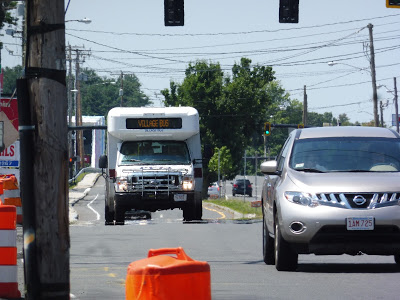 |
| NO! |
Having gotten off our R27 just before the Eastfield Mall (the starting point of the PV), we were waiting on the side of the road, desperately hoping this oncoming minibus would stop for the two teenagers waving like ducks. Thankfully the bus did stop, and we were off down Boston Road. It was basically just a lot of suburban businesses that eventually devolved into industrial buildings.
 |
| An exemplar for the neighborhood. |
We went past two ponds, then outside of the Wilbraham Police and Fire Departments, the R27 left us, and we were on our own. There were a few businesses, then we went through a stretch with woods on one side and the Chicopee River on the other side. After that, there were some houses along the road, then we briefly entered the town of Monson (never heard of it).
 |
| The Chicopee River. |
There were some industrial buildings as we entered Palmer. We also passed a gritty K-Mart, and luckily, we didn’t have to deviate to it. However, this merciful period of relative speed and directness would soon be over. We went over the Chicopee River, passed a big old factory, and merged onto North Main Street.
 |
| Some scenery along Main Street. |
There was a mixture of businesses with parking lots and dense houses along here. Eventually, we came into Palmer Center, and it was a miserable scene. There were some dense retail buildings, but they were in terrible condition and either occupied by sketchy businesses or just completely empty. Outside of an abandoned gas station, we turned onto Thorndike Street.
 |
| Palmer Center, everyone! |
There were a few more businesses and dense houses, but after a cemetery, things got a lot more spread out. We passed some houses for a bit, then a gas station and an interchange with I-90. After a brief woodsy section, we arrived at our first deviation: the Palmer Big Y.
 |
| Entering the parking lot. |
Now, for some reason, the 12:00 trip from the Eastfield Mall changes the route order. This doesn’t sound like a big deal, but oh, it is: on the 12:00 trip, the entire JOURNEY from Palmer Center to the Big Y is a deviation. So we literally had to go all the way back down Thorndike Street to Palmer Center!
 |
| Oh look, it’s that graveyard we passed ten minutes ago going the other way! |
Before getting to the center proper, though, we turned onto Park Street (no, not that Park Street – if only), which went along the side of a small shopping plaza. Outside of a church and a post office, we turned onto Central Street, taking us back to the decrepit businesses of Palmer Center. We also made the ubiquitous stop at the Palmer Senior Center, because of course the route serves the senior center.
 |
| Back here again… |
We headed down North Main Street again, going back the way we had come toward our starting point. However, rather than return to civilization, we stayed on Main Street this time, which was lined with suburban houses. We didn’t stay on here for long, though, because it was time for a cavalcade of deviations!
 |
| That’s the way towards civilization… |
We turned onto Wright Street, then the hilly, woodsy Beacon Drive. This led to the Palmer Green Estates, a housing development, and we looped around there and came back down the hill. After that, we turned again onto Wright Street and looped around the front entrance of the Baystate Wing Hospital.
 |
| The hospital. |
Could we now return to North Main Street? Nope! We had to do one more deviation via Fairview and Fletcher Streets, ostensibly to serve “Laurel Manor,” even though that development is easily accessible from North Main. Regardless, we were finally able to turn onto that street, and after going under I-90, we entered the forest.
 |
| Crossing a river. |
We turned onto Palmer Road, going over the Quaboag River and past a mobile home park. The road crossed over a train track next, then we were running alongside it with practically identical houses on the other side. Eventually, we arrived at a place called Three Rivers, a “town center” of sorts featuring a gas station, an old factory, and a post office.
 |
| Not much here. |
Once we turned onto Main Street and crossed the Quaboag River again, there was a little more town center-y stuff. For a stretch, the street was lined with retail buildings, but like Palmer Center, they were merely shells; many were abandoned. There were dense houses for the most part after that, but we also passed a church and a cemetery.
 |
| A side street. |
We were supposed to make a deviation to “Kirkwood Place,” but at least on my trip, we didn’t and just turned right onto Sykes Street. We passed some Palmer municipal buildings, then there was a section of forests and fields. After going under some telephone wires, houses showed up along the road, which eventually became Palmer Street.
 |
| Going over the Ware River. |
Next, it became South Main Street, and we passed through a mostly residential neighborhood (aside from two retail buildings and a pond). We turned onto River Street, crossing the Swift River and entering Belchertown, then we headed onto Keyes Street. Outside of a convenience store, we turned onto Depot Street, reentering Palmer after another Swift River crossing.
 |
| “YE OLDE GROG SHOPPE” |
There was a playground on the corner as we turned onto Main Street, paralleling the river for a bit. And now, with that long deviation having been completed, we retraced our steps for a while before merging onto Thorndike Road. As it became Pleasant Street, this was the first time in quite a while that we were getting some decent speed and actually going somewhere – not just doing a deviation.
 |
| A hilly side street. |
The curvy road became Church Street as we entered the Thorndike neighborhood. There were dense houses, a playground, a church, and a post office here. It continued to be residential for a while until we reached an old factory and crossed over a canal, then the Ware River.
 |
| The old Palmer Amtrak station! |
The road now became High Street, lined with houses and later, a cemetery. Next, we turned onto Ware Street, a lovely straight section of road lined with houses where we could just speed past everything. It became woods eventually, and it was honestly quite scenic! It basically alternated between houses and forest, even once we entered Ware and the street became Palmer Road. We went over one last river (this route has a lot of river crossings), and finally, after 75 minutes of endless looping, we pulled into the Ware Walmart. Thank goodness!
 |
| Get outta here!! |
PVTA Route: PV (Palmer Village)
Ridership: I can’t find any cold hard numbers regarding the PV’s ridership, and unfortunately, my ride was so long ago that I can’t remember the exact number of people who rode. I think it was around seven, with different people getting on and off locally in different places. That’s not bad for a minibus route, honestly.
Pros: 1. It serves Palmer. 2. It gets decent ridership for a route of its ilk. 3. The end!
Cons: I could talk about the horrendously deviatory route that loops all over itself and takes a grotesquely longer amount of time than just driving, but it should be clear from the review that the route is like this. No, instead, let’s talk about the schedule, because it makes no sense. The first trip actually starts in Belchertown Center at around 7 AM (maybe the garage is there?), then the route operates about every hour and a half until 12:30 or so. Fine. After that, though, there’s a four hour gap until 4:30! From that point, the route runs until 9 PM. Yeah, I’ll say it again: THIS SCHEDULE IS NONSENSICAL.
Nearby and Noteworthy: As part of our expedition out here, Sam and I had to wait multiple hours in Palmer Center. We were hoping the Steaming Tender would offer some entertainment…but it’s closed on Mondays. Sigh…
Final Verdict: 3/10
It’s a pain to get anywhere using this route. It’s so crazy and all over the place that a simple jaunt down the street could take an hour because of all the loops and deviations. Also, what kind of minibus route runs only in the morning and the late evening? I feel like the afternoon would be one of the busiest times of ridership for shoppers! Still, at least it can pick up those Palmer partiers at 9 PM. Woo-hoo!!!!
Latest MBTA News: Service Updates
Park Street
Oh yeah. I’m doing it. You guys have been requesting this for months and months and months, and now it’s finally here. We’re checking a big one off the list today – it’s time to look at what is quite possibly the most iconic station on the MBTA, Park Street!
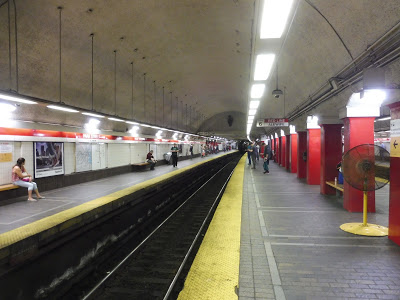 |
| Here’s that Red Line platform you all know and love! |
Everyone’s heard that classic announcement coming into Park Street on the Red Line: “The doors will open on both sides of the train. For elevator service, please exit the left side of the train onto the center platform.” That about sums up the unique setup of the Red Line platforms: there are two side ones, one for each direction, and a center platform with more waiting space and elevators.
 |
| Basically an identical view, except on the other side. |
The platforms themselves are decent. There’s good spacing of benches along the whole station, and plenty of seating is offered on both the side and center platforms. Wastebaskets are a little sparse, though, showing up mostly near the entrances to the Green Line. Thanks to the fact that most of the station consists of two big arches, random pipes are less prominent than at other stations, although the paint from the popcorn ceilings has seen better days.
 |
| High five! Or…Jardell! For anyone who may get that… |
Other amenities at Park Street include the new television screens the T has been putting at stations that show mostly ads. There are also the two hands up where the arches of the station end that are kinda hard to notice if you’re not looking out for them. Finally, at the end of the center platform, there’s an emergency exit staircase that looks like it hasn’t been used in decades.
 |
| The end of the platform. |
Near the Green Line staircases is where the station starts to get busy. Park Street has a nice easy transfer between lines: just walk up the stairs, and you’re at the Green Line. These concourses where the stairs are feature lots of wastebaskets (the highest concentration anywhere on the platform), a few fans (it gets hot down here), and a payphone (I can’t remember if it worked or not).
 |
| Oho, a secret exit! |
Of course, I can’t fail to mention the “secret” exit from the Red Line station! It’s not actually that exciting, but on the ends of each platform, there’s an escalator (or in one case, stairs) that leads up to the street, exit-only. I can’t speak for the other ones, but the one I used from the southbound platform had a funny little sign saying “overhead door”…over the door. Uh…okay!
 |
| Not the iconic entrance, but still nice. |
As long as we’re up here, we might as well talk about Park Street’s various entrances. The one on the east side of Tremont Street, otherwise known as “the one closest to Downtown Crossing,” has some pretty good architecture and signage. I like the glass columns, and there’s a T sign to let everyone know where the entrance goes. There’s an elevator on this side, too, but it’s currently under construction.
 |
| Our first mezzanine! |
This entrance has a pretty small mezzanine, but it gives you everything you need: two fare machines and two fare gates. This one leads into the concourse area above the platforms, meaning it’s a bit of a pain to use if you’re going westbound on the Green Line, but it’s easy to get to the other parts of the station from here.
 |
| Oh…hi, Nathan. Uhh…thanks for holding open the door… |
There’s also the other entrance south on the common, otherwise known as “the one closest to Boylston.” It’s a pretty standard-looking building, but the staircase down is made out of nice-looking marble (or some material that looks like marble). The mezzanine for this one has no fare machines, though – just two fare gates. It leads to the westbound Green Line platforms, so if you’re going in the other direction, it’s sort of a pain to get there.
 |
| Such a big bus hub! |
Park Street is also, of course, the home of the 43 and 55 bus routes. As you can see above, their bus stop is barebones: it’s just a sign. No shelter. No bench. Nothing. Just a sign. Also, the traffic here is so bad that the 43 schedule essentially says, “Yeah, the bus is just gonna get here whenever it wants and leave right away, so, uh, be prepared for that.”
 |
| The elevator entrance. |
Now, the only accessible entrance open at the moment is the elevator along the common. The exterior is really nice: the modern glass shaft comes out with a simple but effective entrance. I particularly like the T logo at the top. However, the elevator itself is a very very very smelly affair, and despite being fully glass, it’s a miserable ride. We will encounter many more smelly elevators throughout this review.
 |
| Ahhhh, the classics! |
Of course everybody knows these entrances! These are so iconic, and they never get old! Well, technically they are old, but you know what I mean. They both have a few wastebaskets outside their doors, and the western one also has a few newspaper boxes. My one gripe with these lovely buildings is that I wish they said the primary Green Line direction for each one instead of just “All Trains” – I always have to figure out which way is which when I’m trying to quickly get onto the Green Line.
 |
| Down the stairs. |
Going down the stairs, there’s an awesome plaque above commemorating the opening of the Park Street Subway on September 1st, 1897 – the first subway in America. Unfortunately, the age of the station does show on this staircase, with some really horrible paint chipping issues on the white walls.
 |
| It’s busy down here! |
 |
| The Green Line platform. |
I’ll start with the westbound Green Line platform, since it’s at least a little less crazy than the eastbound side. Honestly, though, the Green Line platforms are both insane, with people darting around and waiting around in various places. There are two tracks per platform, with the inner track dedicated to B and D Line service, while the C and E Lines board on the outer track.
 |
| An example of typical Park Street insanity. |
The platforms feature a bunch of benches, wastebaskets, and maps among the throngs of darting crowds. It can get really hot down here, due to a mixture of low ventilation and lots of body heat, and that heat is certainly exemplified when you’re down here for twenty minutes to review it oh my God make it stop!!!!!!!!! Ahem…
 |
| Oh, also, here’s a random payphone. |
Other points of note down here include countdown clocks, showing the number of stops away westbound trains are (not very useful) and the number of minutes away eastbound trains are (much more useful). There are also full racks with every bus schedule on the system right on the platform, which is great. I also appreciate the Charlie on the MTA poster and the sign displaying various destinations and which lines to take to get to them.
 |
| Going downstairs! |
To get between the two Green Line platforms, there’s a crossover tunnel. It’s accessible either by a set of stairs or by an elevator of standard, stinky quality. One weird thing about the elevator is that it has completely different button panels for each door! One of them is pretty basic, while the other one has all these complicated buttons about opening individual doors and holding them open. Why does this discrepancy exist? I have no idea.
 |
| Crossing over. |
The underpass itself is pretty underwhelming. It has low ceilings, it’s aesthetically boring, and there are random holes in random places on occasion. Still, it’s just an underpass, so looks don’t matter all that much, and the mosaic work does at least have try to look nice.
 |
| The eastbound side. |
And here’s the eastbound side of the Green Line platform! Can you see the possible safety hazard? The entire outer track is a crossing. People can walk over it at any time! Imagine how terrifying it would be to drive a train through here! It’s no wonder operators ring their bells like madmen as they come into the station!
 |
| Kitschy souvenirs, anyone? |
This platform houses the T Underground souvenir shop, offering a lot of weird, semi-sketchy stuff with lots of flashy lights and grammatically-dubious signs. I guess it’s nice to have a store right on the platform, though. Moving on, there’s an ATM, a few more benches, and an outdated system map.
 |
| Our final mezzanine area! |
Finally, we come through a passageway on the outer platform and enter a mezzanine that feels like it’s been under construction forever! There’s not much in here aside from some wastebaskets, entryways to the Red Line platforms, and one of the station entrances we looked at a while ago. There’s also a countdown clock displaying Green Line arrivals, but it really should display Orange Line arrivals since it’s at the entrance to the Winter Street Concourse…but we won’t be going down that concourse just yet!
 |
| Two blurry trains. |
Station: Park Street
Ridership: This is the fourth-busiest station on the MBTA in terms of fare entries, with 19,653 riders per weekday! That doesn’t even account for the insane number of transfer passengers here: almost 30,000 people go between the Red and Green Lines in each direction per day (60,000 total), making this the busiest transfer station on the entire system. Also, on a weird side note, I find it interesting that 755 people who enter this station actually use the Winter Street Concourse to get to the Orange Line at Downtown Crossing!
Pros: This is one of the easiest transfers on the system, featuring quick and easy staircases between the Red and Green Lines (and a hallway to the Orange Line, if you want to count the Winter Street Concourse). Indeed, Park Street as a whole works very well functionally, with many entrances and mezzanines, allowing people to come in from a few different places around the area. However, it’s still easy to navigate, and it doesn’t have the labyrinthian qualities of other downtown transfers. The station features many amenities, particularly on the Green Line platforms, for as much passenger convenience as possible. Finally, although it doesn’t necessarily work in practice, Park Street makes a decent effort to look nice, which can’t be said for some of the other downtown stations on the T.
Cons: Park Street, especially the Green Line portion, is just a gigantic melting pot of pure insanity. Getting through the crowds here can be tough, especially at rush hour, and it doesn’t help that all that body heat comes together to make temperatures borderline unbearable. Every elevator at this station is guaranteed to smell – indeed, I once saw literal, actual human feces in one of them. Although Park Street tries to look good, and I appreciate that, it often falls flat. This may be one of the most (if not the most) iconic stations on the T in terms of appearance, but that appearance is often old and antiquated, more so in some areas than others.
Nearby and Noteworthy: This station is, of course, best known for its prime location right next to the Boston Common. Aside from that, you’ve also got the Massachusetts State House, Beacon Hill (some parts of it are easier to access from here than Charles), and various other historical sights.
Final Verdict: 6/10
On one hand, trying to brave the crowds between the Red and Green Lines at rush hour can be a total nightmare. On the other hand, this station is set up pretty darn efficiently (especially given its age!), and it’s just so darn iconic – those main entrances! They’re so beautiful! However, the hub is still plagued with a host of problems, including the lack of a proper bus area, questionable appearances in some areas, and human feces in an elevator. Did I mention that?? The station ends up being fairly middle-of-the-road for me, although it’s certainly better than its neighbor along the Red Line. Believe me, I’ll have a lot to say for that review…
Latest MBTA News: Service Updates
Airport Terminals
The last Silver Line reviews! It’s time to head up to the airport and see what kinds of “stations” the SL1 has to offer.
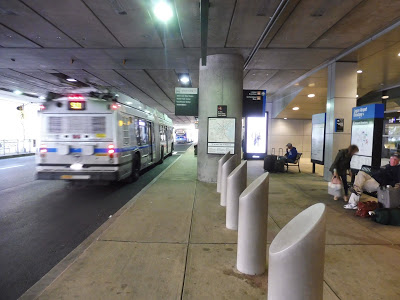 |
| A bus leaving Terminal A. |
Station: Terminal A
Ridership: The stop gets 484 riders per weekday.
Nearby and Noteworthy: “This is Terminal A, serving: Delta Airlines, Delta Shuttle, Southwest, and WestJet, with the exception of international arrivals which arrive at Terminal E. Ticket counters and gates are located on the second level.”
Final Verdict: 5/10
This is basically what you’d expect from an SL1 airport stop: there are a few benches, a few maps, and a rather inaccurate countdown clock. Since it’s on the lower arrivals level, every sound from every car and bus is magnified, and it can get rather noisy here. Thus: meh.
 |
| Terminal B, Stop 1. |
 |
| Terminal B, Stop 2. Very different, eh? |
Stations: Terminal B Stop 1 and Terminal B Stop 2
Ridership: Stop 1 gets 367 riders per weekday, while Stop 2 gets 246.
Nearby and Noteworthy: “This is Terminal B Stop 1, serving: Air Canada, Air Canada Express, American Airlines Gates B4 to B14, American Shuttle Gates B15 to B19, and PenAir, with the exception of international arrivals which arrive at Terminal E. Ticket counters and gates are located on the second level.”
“This is Terminal B Stop 2, serving: American Airlines Gates B30 to B36, Spirit Airlines, United Airlines, and United Express, with the exception of international arrivals which arrive at Terminal E. Ticket counters and gates are located on the second level.”
Final Verdict: 6/10
These two stops are basically the same, so I’m doing them in one. Terminal B has the same amenities as Terminal A, except these stops have at least a little bit of outside space and foliage, with a nice long bench. It’s not much, but it does bump the terminal up a point.
 |
| Terminal C‘s island platform. |
Station: Terminal C
Ridership: This stop gets the highest ridership at the airport, with 687 people per weekday.
Nearby and Noteworthy: “This is Terminal C, serving: Aer Lingus (all arrivals and departures), Alaska Airlines, Cape Air, JetBlue, Sun Country, TAP Portugal, and Virgin America, with the exception of international arrivals which arrive at Terminal E. Ticket counters and gates are located on the second level.”
Final Verdict: 2/10
This one sucks. I hate how it’s located in the middle of a traffic island, so you have to cross a few lanes of vehicles to actually get here. There’s only one bench, and it’s right next to a pole with paint chipping away and a broken payphone haphazardly attached to it. This is the worst stop at Logan, especially considering it gets the highest ridership!
 |
| And finally, here’s Terminal E! |
Station: Terminal E
Ridership: Strangely, Terminal E gets the exact same amount of people per weekday as Terminal A: 484.
Nearby and Noteworthy: “This is Terminal E, serving: Aeromexico, Air France, Alitalia, Avianca, Azores Airlines, British Airways, Cathay Pacific Airways, Copa Airlines, El Al Airlines, Emirates Airlines, Hainan Airlines, Iberia, Icelandair, Japan Airlines, Lufthansa, Norwegian Air, Porter Airlines, Qatar Airways, Scandinavian Airlines, Swiss Airlines, Thomas Cook Airlines, Turkish Airlines, Virgin Atlantic Airways, and WOW Air. The following carriers are international arrivals only in Terminal E: American Airlines, Delta Airlines, JetBlue, and TAP Portugal. Ticket counters and gates are located on the second level. This is the last stop at Logan Airport.”
Final Verdict: 6/10
I guess I’ll give this the same score as Terminal B, since it offers basically the same amenities: maps, a countdown clock, an outdoor area with some foliage, and some benches to sit at out there. And with that, all the Silver Line stops are done! I wonder what review is coming up next…
Harbor Street, Tide Street, 23 Drydock Avenue, 27 Drydock Avenue, 88 Black Falcon Avenue, and Design Center
The SL2 now, huh? We’re really gonna review SL2 stops? We’re gonna walk around an industrial area to review shelters and signs? Sigh…duty calls, I guess…
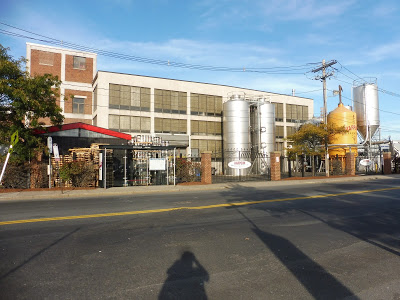 |
| I think the SL2’s been drinking some of the Harpoon Brewery’s exports, am I right?? Ahem…this is Harbor Street. |
Station: Harbor Street
Ridership: 94 boardings per weekday…something tells me a lot of the ridership will be like this.
Nearby and Noteworthy: BEER BEER BEER BEER BEER
Final Verdict: 2/10
This station offers shelters on both sides, which I guess is nice, especially since outbound ridership from here is basically nil. That being said, apparently the Silver Line doesn’t even stop here in the outbound direction, since the outbound side just has a sign for the 4! Whoopsie!
 |
| A bus stopping at Tide Street. |
Station: Tide Street
Ridership: This is the busiest stop on the independent section of the SL2, with…461 riders per day? Oh…that’s not a lot…
Nearby and Noteworthy: No, just some factories and weird buildings.
Final Verdict: 3/10
This one improves slightly upon the last one with the inclusion of wastebaskets on both sides! It also correctly implements Silver Line signs in both directions, which is certainly a step up.
 |
| 23 Drydock Ave. Thanks to the big 23 sign! |
Station: 23 Drydock Avenue
Ridership: They moved the stops a bit since the last Blue Book came out, so I guess I’ll use the data from the former 25 Drydock Ave stop: 171 boardings per weekday.
Nearby and Noteworthy: This stop is dominated by the huge Design Center!
Final Verdict: 2/10
It’s a fine shelter, but there’s no sign. How are people supposed to know what bus stops here?
 |
| 27 Drydock Ave. |
Station: 27 Drydock Avenue
Ridership: This one isn’t really comparable to anything that existed before…maybe we could split the 25 Drydock Ave ridership in half?
Nearby and Noteworthy: The Design Center again.
Final Verdict: 1/10
This one has the opposite problem of 23 Drydock Ave – this is just a sign!
 |
| The Black Falcon corner stop. |
INTERMISSION: This stop on the corner of Black Falcon Ave and…uh…Black Falcon Ave is only served after 8 PM and during snowstorms. It seems like buses also stop here on weekends (instead of going around the Black Falcon loop), but I don’t think they’re supposed to do that. This isn’t an actual stop, per se, but I did want to give it a mention.
 |
| 88 Black Falcon Ave…what a weird place for a stop. |
Okay, this is a weird one, so I’ll dedicate a bit of time to it. The SL2 actually goes out of its way on a deviation to serve this stop. It runs out next to the water, loops around to the sign, and then just rejoins the regular route. It’s so strange!
 |
| And then there’s just this unused shelter… |
Station: 88 Black Falcon Ave
Ridership: 124 riders per weekday.
Nearby and Noteworthy: Geez, I dunno…just another industrial building.
Final Verdict: 1/10
This one is just stupid. It’s pointless for buses to deviate an extra block – I’m sure people can walk that much extra to get to the corner stop described above, because that’s what the route should use. This loop is a waste of time.
 |
| Why is the Design Center stop way over here? |
Station: Design Center
Ridership: A whole 48 people per weekday. Geez…
Nearby and Noteworthy: The edge of the Design Center, as well as the Black Falcon Cruise Terminal. And the Thompson Island Ferry terminal, for anyone who wants to deal with that boat’s crazy schedule. I should ride it someday…
Final Verdict: 1/10
Yes, it has a shelter and a sign and everything, but I just can’t get over the stupid placement of this thing – why is it to the west side of the intersection? That means the bus has to travel all the way around the block to get here. It really couldn’t have just been placed on the eastern side or on Design Center Place so vehicles could just turn? Sure, there wouldn’t be room for a layover point, but the route could easily layover somewhere else, such as 88 Black Falcon (if that deviation is gonna be there, it might as well be useful).
Worcester Square, Massachusetts Avenue, Lenox Street, and Melnea Cass Boulevard
What’s on the ballot today? Oh, more Silver Line stations? Cool, cool…let’s just get Washington Street done with, then.
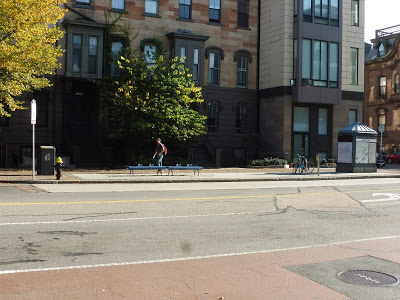 |
| What the heck is this?? Well, it’s Worcester Square. |
 |
| The two sides of Mass Ave. |
 |
| A hubway station, with Lenox Street in the background. |
 |
| Good thing we have Melnea Cass Boulevard for all the school buses! |
Herald Street, East Berkeley Street, Union Park Street, and Newton Street
This is painful, but in order to say I’ve truly reviewed every MBTA rapid transit stop, I kinda-sorta have to do the Silver Line ones too. Yup, I’ve stooped down to reviewing literal, actual bus stops. This should be interesting…
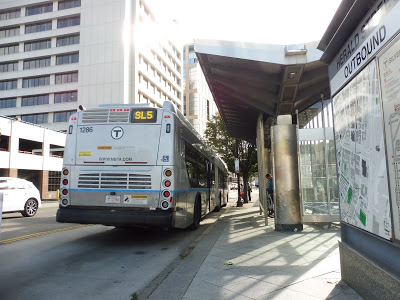 |
| A bus leaving Herald Street. |
 |
| The inbound stop for East Berkeley Street. |
 |
| Pretty busy for a Sunday – the inbound Union Park Street stop. |
 |
| The two sides of Newton Street. |
Morton Street
Let’s take care of a one-off Fairmount Line review, shall we? This is Morton Street. It’s a Fairmount Line station in Mattapan. That’s all the background you need.
 |
| There it is! |
Morton Street Station is located on the road of the same name, a four-lane behemoth of speeding traffic. It’s too bad, then, that the station entrance is only on one side of the road, with no crosswalks for a while on either side! It’s not too big of a deal, I guess, but it’s definitely a little annoying. The entrances are marked with a few T symbols and station signs. There’s a secondary entrance to the outbound platform on Flint Street.
 |
| Coming down on the inbound side. |
The inbound side of the station has a lot more amenities than the outbound, such as a staircase and a ramp (the other side just has the latter) and some bike racks. This side also has a little parking lot, which is interesting. The MBTA website claims there’s no parking here!
 |
| The platform. |
 |
| No train picture, unfortunately, but here’s another one of the platform. |
Pros: As a normal Fairmont Line station, Morton Street features luxurious high-level platforms, beautiful convenient shelters, and more benches than are probably necessary, since this thing can’t generate any kind of ridership with an hourly Commuter Rail service because this is destined to be a rapid transit line ARGHHHHHHHHH!!!!!
Cons: I gotta say, this station is somewhat lacking in the wastebaskets department! Other than that, it’s really just the fact that there needs to be way more frequent service here, because the Fairmount Line as it is is just a joke.
Nearby and Noteworthy: There are some businesses to the east of this station, but they don’t look particularly appealing…
Final Verdict: 7/10
It’s a Fairmount Line station. The end!
Latest MBTA News: Service Updates
Logan Airport Shuttle: 55 (Serves All Terminals to subway station and to Rental Car Center)
So I found out that before I can do the big review, I have to do some other reviews that sorta pertain to the big review in a way, mostly for dramatic purposes for when the big review finally comes out. It’ll become clear at some point. Well, anyway, before I can do the other reviews before the big review, I’m gonna patch up the time by taking care of some reviews in my backlog of my reviews, not pertaining to the other reviews or the big review. Thus, here’s my review of the Logan Airport 55 route review. Review? Review!
 |
| The bus at Terminal A. |
The 55 is basically a combined version of the 22 and 33 that runs in the late evening and early morning in lieu of those routes. That’s about it. So we started at Terminal A and proceeded to, yes, Terminal B – stops 1 and 2. From there, and I know this is a big surprise, we went to Terminals C and E! Oh, and there was also that weird Massport control tower stop between B and C that no one ever uses…
 |
| Oooh, blurry! |
After Terminal E, we headed down Service Road, passing a gas station, some parking lots, and a few airplane hangars. Eventually we turned into Airport Station, then from there we went down Transportation Way. There was a park on one side, and we curved around it before running up to the upper level of the Rental Car Center. Alright, review over!
 |
| Another 55 getting ready to go back to the airport. |
Logan Airport Shuttle Route: 55 (Serves All Terminals to subway station and to Rental Car Center)
Ridership: Since this route operates during the airport’s off-peak hours, ridership is pretty light. My trip had maybe seven people in total.
Pros: It makes sense that during times of lighter ridership, Massport combines the 22 and 33 into one route. It does mean a longer ride to Terminals C and E, although in the case of E, most international flights don’t leave when this route runs, so it’s not too big of a deal. The route operates with consistent frequency, and you should never have to wait too long for a bus.
Cons: It’s kinda weird that this uses 60-foot buses, isn’t it? I mean, there really doesn’t seem to be enough ridership to justify them, and I imagine the costs for running them are higher than normal 40-foot buses.
Nearby and Noteworthy: Every terminal of the airport! Woah!
Final Verdict: 6/10
I don’t really have all that much to say about the 55. It’s just a fairly meh shuttle that runs when the ridership isn’t high enough to support the 22 and 33. Basically, you’re in for a slow, quiet ride in a 60-foot bus with very few people on it.
Latest MBTA News: Service Updates
PVTA: R27 (Springfield/Eastfield Mall via 16 Acres-Wilbraham)
As I continue to work on my big review that I know all of you will like quite a lot, let’s take a look at a defunct PVTA route! The R27 was eliminated pretty soon after I left Amherst, so I’m glad I got the opportunity to ride it – and it was hard to find even when it existed! Having been on this elusive bus, I can safely say that…yeah, good thing the PVTA cut this thing.
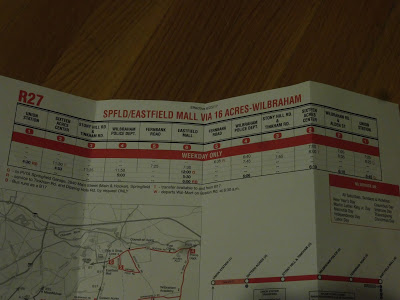 |
| This schedule is Exhibit A! |
Oh boy, it’s one of these schedules, huh? More dashed lines than actual timepoints? Every single trip has some sort of letter attached to it that makes it different from all the others? Cooooool. I’d also like to point out that only three of the five trips actually operated as R27s; the two evening ones were deviated B17s.
 |
| Well, here’s the stop…or something… |
Sam and I took a B17 to Sixteen Acres Center, and we had half an hour to wait for the R27 (despite the fact that the schedule promised a “transfer to and from the B17”). We literally spent almost all of that time poring through the horrible PVTrack app looking for the right R27 stop – there were so many of them, and they were in seemingly no order at all! We were paranoid about missing the bus (or worse, the bus not coming at all), so we settled for the stop after Sixteen Acres Center, which was pretty desolate.
 |
| IT EXISTS!!!!!! |
We were already past the suburban businesses of Sixteen Acres Center at this second stop – by this point, it was all residential. We headed down Wilbraham Road past lots of houses; eventually we entered Wilbraham, and the name changed to Springfield Street. It already started to feel more rural, with more trees and larger spaces between houses.
 |
| A pleasant side street. |
For some reason, the R27 was planned in the most complicated way possible. It had two deviations along the route that certain trips served, and my trip was doing one of them. Thus, we turned onto Stony Hill Road, which was more houses, then it ran straight through a golf course. We turned onto Tinkham Road next, passing more sparse houses.
 |
| Fore! |
We went by the entrance to the Minnechaug High School, then a cemetery, and next, we turned onto Main Street. There was farmland for a bit, then it went back to being residential once more. Eventually, at the intersection with Springfield Street, we reached Wilbraham Center! It was basically a few businesses and a small common…and Main Street dissolved into woods a few seconds after passing through the downtown.
 |
| Welcome to Wilbraham Center! YAY!!!!! |
Houses came back pretty soon, and they were the only thing along here for a while. Eventually we went by a church, and soon after, we turned onto Boston Road. This was completely different from before: now there were auto shops, suburban businesses with parking lots, and…a few ponds!
 |
| This is me trying to get a picture of one of them… |
The suburban sprawl continued for basically our entire run on Boston Road. Now, Sam and I were trying to catch the Palmer Village Shuttle from the Eastfield Mall, where this route terminates. Somehow, though, our bus was late (a rarity for PVTA!) and we had to get off just before the mall in order to catch the PV on its way out. Still, there isn’t much to the end of the R27 – all it does is deviate into the mall, and that’s the end of the route.
 |
| This could very well be the last picture ever taken of an in-service R27! |
PVTA Route: R27 (Springfield/Eastfield Mall via 16 Acres-Wilbraham)
Ridership: My ride featured a grand total of one other person! Cool! According to the PVTA, this route got 11 riders per revenue hour, which seems like a lot. I mean, maybe the rush hour trips got busier, but my midday trip was empty.
Pros: The PVTA must have some political obligation to serve Wilbraham, because there can’t be any other reason why fixed-route buses are running through such a low-density area. In that sense, I guess this route provided that service?
Cons: The R27 was just a confusing mess – its schedule was completely nonsensical! Also, the ridership was really low, and the route was just way too complicated for its own good, with too many deviations and service variants. The stops were organized really badly on the app, too, and the route itself was insanely hard to find in real life!
Nearby and Noteworthy: Wilbraham Center is not a thriving hub of activity by any means, but…yeah, that’s about all you’ve got on this route.
Final Verdict: 2/10
The only thing keeping this from a 1 is that if the numbers are to be believed, this route got at least a little ridership. Anyway, the way they replaced it was well-done: they just deviate three rush hour B17 trips per day to Wilbraham now. It doesn’t affect that route’s frequency, and B17 riders aren’t impeded at all – the ride takes the same amount of time, with the added bonus of less padding on those trips. That means less waiting at random stops! Yay! This is much simpler and more convenient than what the R27 was like, so I’m really glad they integrated the two routes.
Latest MBTA News: Service Updates
Harvard Shuttle: Crimson Cruiser (Quad – Mather House via Memorial Hall)
Might as well crank this one out while we’re on the topic of Harvard Shuttles. The big review that’s coming will be really good, I promise!
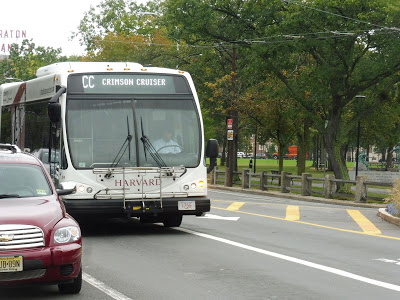 |
| The bus alongside Cambridge Common…and a car that got in the way. |
I got on at Garden Street along Cambridge Common, and we looped around the Harvard Bus Tunnel onto Mass Ave. After going by the Harvard Law School, we turned onto Everett Street, then Oxford Street, which took us past the Harvard Natural History Museum, among other buildings. Next, we turned onto Kirkland Street.
 |
| Ah, much brighter than the Extended Overnight! |
We pulled into the Memorial Hall deviation, and…oh, cool, we were early? Great, fun, let’s wait around. Luckily, we were only stuck here for about a minute, and we were soon off to make our two-block jog because of one-way streets. Finally coming onto Quincy Street, we ran alongside Harvard Yard and dropped someone off at the Lamont Library.
 |
| Somewhere on some side streets. |
After the library, we cut our way down Bow Street, curving down onto DeWolfe Street. This took us down to Cowperthwaite Street, where we arrived at our Mather House stop…four minutes early. Sigh…alright, more waiting…
 |
| No one’s on board. At least we have the nice poofy seats! |
Finally, it was time to go, so we went up Banks Street, then looped around to Mass Ave. We ran on this all the way up to Harvard Yard, where we made the stop at Holyoke Gate, then continued around the yard past the Red Line station. After that, we looped around the bus tunnel again in order to get back onto Garden Street, which we took out of the square and back to the Quad…where the bus was early. Again.
 |
| Aw man, the sign is off! |
Harvard Shuttle Route: Crimson Cruiser (Quad – Mather House via Memorial Hall)
Ridership: Here’s the lowdown for morning ridership: from the Quad to Harvard Square, the bus gets packed. Going around the Memorial Hall loop, you might see one or two people; ditto for Mather House. Then the bus loops empty back to the Quad and gets another huge load of people for the trip back down to Harvard. In the afternoon, I imagine the Quad traffic switches to the other direction, but I’m pretty sure the other ridership camps still stay light.
Pros: This route provides crucial weekend morning service around Harvard, which is clearly well-used by students. There’s also service for a few trips weeknights, replacing the former River Houses B. After we establish the fact that this is an important route, though, it all goes downhill…
Cons: Firstly, this route has the same earliness and timing problem that the Extended Overnight has: it has mid-route layovers, and it runs with uneven 35-minute headways. Unlike that route, though, traffic is more variable during the day, and getting rid of layovers to increase frequency may not be the best idea just in case an unexpected jam occurs. Instead, a better solution to run more frequent service would be to cut one of the deviations – either Memorial Hall or Mather House. Neither one gets very high ridership, and getting rid of one would easily allow for half-hourly service. However, I’d also like to point out that the 1636’er, which runs weekend afternoons and replaces this route, gets two buses and runs every 20 minutes. Why does that route get more service? It’s basically the same thing as this one (almost), except in the afternoon and evening! Clearly the Crimson Cruiser would benefit from more service – it can get really crowded to the Quad!
Nearby and Noteworthy: Well, you’ve got all of Harvard Square, I guess! Oh, except for Peabody House – this route unfortunately doesn’t perform that “important,” “useful” deviation.
Final Verdict: 5/10
The Crimson Cruiser’s main function, at least based on ridership, is getting people between Harvard Square and the Quad. The other two deviations, as far as I’m concerned, are pretty unnecessary, although probably political – I doubt Harvard could eliminate them. Still, something has to be done about those crowds, and the solution might have to be an extra bus. After all, the 1636’er gets another one! Why can’t the Crimson Cruiser have one too?
Latest MBTA News: Service Updates

